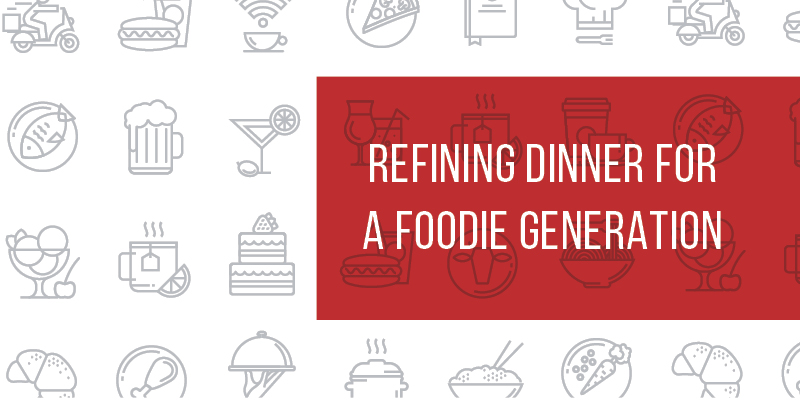
U.S. birth rates are falling fast, but spending is not slowing down. In fact, the baby market is bigger than ever before. Consumers are expected to spend more than $66 billion on baby products in 2017 — three times more than what was spent four years ago. So what’s causing this spending to skyrocket? You can blame that on Millennials.
Millennials are having children at an older age than previous generations — the ripe old age of 26. With the same gusto Millennials apply to any new journey, they are trading their independent lifestyles for a totally new experience — parenthood. Because they’re waiting until later in life to have children, more Millennial mothers are in the workforce with higher incomes and busier lives when they start their families. More money and less time means Millennials tend to be more willing to pay for premium and niche products and services that will make their lives easier.
Trends in Pregnancy
Health Tracking, Just to Be Safe
Millennial moms are using new tech products to keep an extra eye on their baby’s and their own health during and after their pregnancy. For example, Biobands and Bellabeat monitor a baby’s progress within the womb, and Lullabelly lets you sing songs to the baby and teach your baby lessons. Post-birth products such as tracking socks and tech-enhanced changing pads keep an extra eye on your baby’s heart rate, weight and overall health.
But Millennial pregnancy isn’t all “Inspector Gadget.” When it comes to the actual birth, more Millennial moms are opting for a more holistic experience, employing midwives and delivering at birthing centers for their home-like and comforting feel rather than going to a traditional hospital.
Changing Social Norms
Last January, #BeyTwins took the Internet by storm, but Beyoncé isn’t the only Millennial parent to tweet about her pregnancy in the 21st century. From hashtags to gender-reveal videos, sharing updates online with friends, family and even strangers is on #trend. As more families and friends live farther apart, Millennial parents use the internet to share their pregnancy experiences.
Trends in Parenting
Fewer Ashleys and Jacobs, and More Camerons and Dakotas
Millennial parents are taking a less gender-specific approach to parenthood by allowing their kids to dress however they’d like, choosing more unisex names and enrolling their children in co-ed sports. Oh, and kiss traditional gender roles goodbye — with more moms in the workforce, the number of stay-at-home dads has doubled since 1989.
Relaxed Parenting Approach
No helicopter parenting here — new parents are more hands off. Today’s parents tend to encourage their children to explore and discover organically rather than being told to behave a certain way. With “third-child style” parenting, Millennial parents aim for children to develop independence, creativity and responsibility by solving problems on their own, and asking parents only for guidance.
Millennial Consumer Trends Translate to the Baby Market
Consumer trends driven by Millennials are shaking up the baby market, including the emphasis on safe, eco-friendly products; nutritional organic food; functional design; and cross-brand, upscale products.
From diapers and mattresses to dishwasher soap, Millennial parents want natural, eco-friendly products that are non-toxic and chemical free. They also demand that products be easy to use, mess free and nutrient rich to better fit with modern families’ on-the-go lifestyles. Practicality and convertibility are also important. Products should save parents money, grow with each child’s life stage and lessen environmental impact. Millennial parents also want to use preferred brands for their children, influencing a trend in cross-brand outfits and furniture for children.
Implications for Brands and Marketing
So how do you captivate new parents in this sea of products? To appeal to the modern parent, brands need to connect digitally, stay relevant and promote value. Companies can cater to Millennial parents by developing high-tech, stylish, quality products and staying in touch with consumers through culturally relevant messaging.
To learn more about how this shift is impacting brands and marketing, request our full report.
August 1, 2017 | Research

Since SeaChange Print Innovation’s launch, we’ve had a blast using bold colors, playful headlines and eye-catching print techniques to tell its story. One of our creations recently earned a 2017 Summit Creative Award.
This international competition, which drew more than 5,000 submissions, highlights innovative and creative concepts, strong executions and user experience, and the ability to communicate and persuade.
The WBE Certification Campaign we created for SeaChange, which included brand identity, a unique mailer with asymmetric fold, a capabilities kit, a website and a trade show toolkit, was awarded Silver in the Integrated Campaign category.
We’re excited about the award and, even more so, thrilled to have such wonderful clients to work with.
“There was never a doubt that the Fusion Hill creative work would win! I am so thrilled to hear this and can’t wait to get share the big news. … Thank you for the AMAZING partnership and making us all look so good!”
— Wendi Breuer, CEO/President of SeaChange
July 25, 2017 | Research

What do the young adults in your life like to eat? Are they Chipotle fans? Starbucks addicts? Taco truck aficionados?
For the past three years, we’ve taken a close look at Generation Z’s eating habits in the context of their lives as newly independent consumers. It’s driven by a favorite client of ours that specializes in consumer packaged-goods and desires to better reach and delight this generation both on and off campus. And it includes our annual presentation to collegiate dining service representatives from across the country at the In Front of the Future conference.
Gone are the days of mystery meat, lifeless vegetables and cardboard-like pizza. Today’s college dining halls are vibrant representations of the students they feed. They reflect Generation Z’s desire for an authentic experience that leaves them feeling closer to the food they are eating, in an open and welcoming space.
So how are college dining halls redefining themselves in order to meet the needs of students? They’re sourcing locally, investing in sustainable ingredients and practices, and reaching out to the communities they serve to build a strong, authentic brand that resonates.
Sound different than what you remember? We sure think so. This generation’s ability to cultivate new trends and ideas keeps us on our toes, and we love helping our clients get to know the digitally native, always-connected group that will soon make up 40% of all consumers. Want to know more? Connect with us.
July 17, 2017 | Research

What do you picture when you envision the traditional American family? It’s probably different than the person sitting next to you, and the person sitting next to them. What the American family entails is a visual that continues to change, and brands across the country are taking note. Cheerios, Tylenol and Wells Fargo have all rolled out brand campaigns featuring new depictions of American families. From single-parent households, to both blended and interracial families, these campaigns reflect a major shift in the concept of “the American family.”
So – what’s behind the shift? We found that changing attitudes toward partnerships, different approaches to raising children, and gender roles, particularly among young adults, are all contributing factors.
Trends in Partnership
Which box do you check when filling out forms? The results are across the board, and a lot different than they ever used to be. Younger adults, specifically, have exhibited more ambivalence toward the concept of marriage. More and more Americans are postponing or forgoing the ceremony altogether. Many of these couples are choosing to cohabitate or possibly even raise children together, sans matrimony. Marriage isn’t completely out of the picture, however – many young adults want to get married but are waiting until they are older and more financially prepared.
And don’t rule out the d-word. While divorce is at its lowest rate in more than 35 years, it is still prevalent, and significantly contributes to this change in American family structures.
Trends in Raising Children
The Melting Pot
American families are more racially diverse than they ever have been, due to both increased immigration and increased visibility and acceptance of interracial marriages. Consequently, these trends are causing an uptick in the number of interracial births. There are also more children growing up in multigenerational households, a rise attributed to a more ethnically diverse population where multigenerational living is more common.
The New Normal
The makeup of American families is changing too. Since 2015, only 46% of children are living in a home with two married, heterosexual parents in their first marriage. Divorce has also shifted the family landscape. More and more divorced couples remarry, create “blended families” and raise children from previous marriages alongside step- or half-siblings.
Free to Be You and Me
With LGBTQ marriage and adoptions on the rise, today’s kids are now more likely to have two dads or two moms. This has significant economic implications – in 2015, LGBTQ consumers contributed $917 billion to the economy. As more LGBTQ partners become parents, this spending will likely increase.
The Unattached
Today, single households are the second-most-common type of household in the U.S. And, even though singles may bring in less income than their married counterparts, they still contribute a total of $1.9 trillion to the economy. In the modern world, singles are considered families – 26% of children are raised by a single parent.
Trends in Gender Roles
Every day more and more women are enrolling in and graduating from college, and the American economy is feeling the effects of this major swing. No longer does the era of the stay-at-home mom reign supreme, as more women are both raising families and pursuing careers. This new trend requires a balancing act to keep the household in order – for instance, men and women share household responsibilities more equally than in the past. And, with an increased household income, women remain economic powerhouses in the housing and automobile markets.
Implications for Brands and Marketing
As family types continue to diversify, their power as consumers is amplifying. The door is open for more segmented or targeted marketing that embraces and showcases the diversity of family types.
In the words of Chevrolet’s ad campaign, “The New Us: While what it means to be a family hasn’t changed, what a family looks like has.”
To learn more about how this shift is impacting brands and marketing, request our full report.
June 15, 2017 | Research









